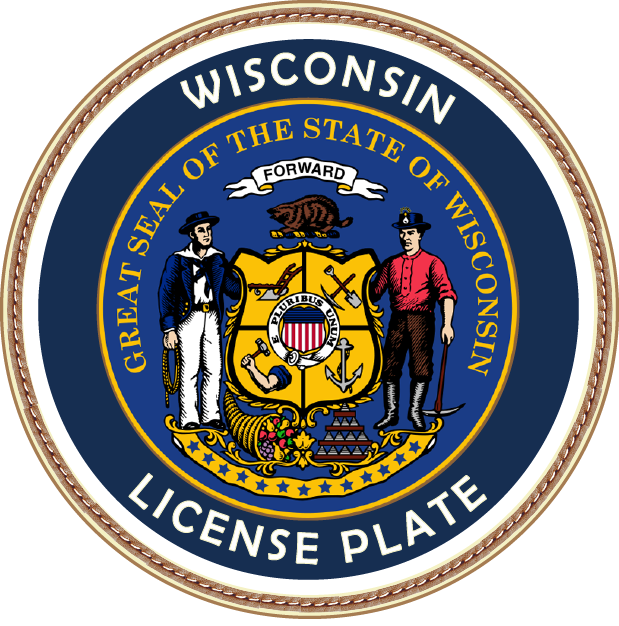The History of Wisconsin License Plates
Wisconsin license plates have evolved dramatically since the state first required vehicle registration in 1905. These plates tell the story of Wisconsin’s transportation, design, and technological progress over more than a century. From hand-painted wooden signs to reflective, machine-produced plates, each generation reflects the state’s ingenuity and pride.
Early Days: The First Wisconsin Plates (1905–1920)
Wisconsin joined early U.S. states in regulating automobiles in 1905. The first license “plates” were often made of leather, wood, or simple metal, issued by local clerks rather than the state. Because there was no standard design, early plates varied widely across counties.
Many early Wisconsin drivers crafted their own plates—often hand-painted wooden boards or metal tags with numbers stenciled or embossed. This made for colorful but inconsistent vehicle identification, challenging for early law enforcement efforts.
By 1910, Wisconsin began transitioning to metal plates, typically brass, aluminum, or steel. Local blacksmiths and metalworkers produced these plates using simple stamping tools, which improved visibility and durability compared to earlier versions.
Statewide Standardization (1920–1940)
In 1915, Wisconsin centralized license plate production, creating a uniform statewide standard. This ended the locally made era and ensured all vehicles displayed consistent identification. By 1918, new plates were required annually—a practice that funded road maintenance and simplified enforcement.
Material shortages during World War I and II led Wisconsin to experiment with substitutes like fiberboard, cardboard, and compressed sawdust. These creative solutions kept registration systems running despite metal rationing.
Design Evolution (1940–1970)
The 1930s and 1940s introduced more stylistic designs, inspired by Art Deco trends and improved visibility. Wisconsin experimented with color schemes such as blue-on-white, white-on-blue, and black-on-yellow to differentiate years.
Reflective materials were introduced in the 1950s, significantly enhancing nighttime legibility and safety. Wisconsin quickly adopted this technology, making it one of the first states to prioritize reflective visibility on plates.
In the 1960s, the slogan “America’s Dairyland” debuted on Wisconsin plates, celebrating the state’s agricultural and dairy heritage. This branding transformed license plates into symbols of regional pride and identity.
Modern Era: Specialty and Personalization (1970–Present)
Wisconsin introduced personalized plates in 1978, giving drivers the ability to create custom combinations for an additional fee. This innovation not only raised revenue but also gave citizens a fun and personal way to express themselves.
The 1980s brought specialty plates supporting causes and organizations—such as universities, veterans, charities, and environmental efforts. These designs allowed Wisconsinites to proudly display their affiliations while contributing to meaningful programs.
Modern manufacturing introduced advanced inks, security laminates, and micro-printing to prevent counterfeiting. Today’s plates incorporate materials compatible with automated tolling, traffic cameras, and digital enforcement systems.
Notable Wisconsin Plate Designs
- 1976 Bicentennial Plates: Issued to celebrate America’s 200th anniversary, featuring red, white, and blue designs.
- 1998 Sesquicentennial Plates: Marked Wisconsin’s 150th year of statehood with historical imagery and symbols.
- Cause-Support Plates: Modern plates that fund breast cancer research, environmental conservation, education, and more.
Collecting Wisconsin Plates
Vintage Wisconsin plates have become prized collectibles. Enthusiasts seek rare early examples—especially handmade wooden or wartime substitutes. Factors that influence collectible value include rarity, design uniqueness, and condition.
Collectors use license plates to study Wisconsin’s industrial and cultural history, as each era reflects changing materials, technologies, and social priorities.
Manufacturing Changes
Early plates were handcrafted by local artisans. Today, computer-controlled equipment produces plates with precise embossing and advanced coatings. Wisconsin’s modern manufacturing emphasizes eco-friendly practices, including recyclable aluminum and sustainable production methods.
Wisconsin License Plates Today
Modern Wisconsin plates combine tradition and technology—serving as tools for vehicle identification, civic pride, and security. From humble wooden beginnings to high-tech aluminum and reflective finishes, these plates trace the evolution of transportation and state identity.
Understanding the history of Wisconsin license plates provides insight into over a century of innovation, community spirit, and practical design that continues to shape the state’s roads today.
